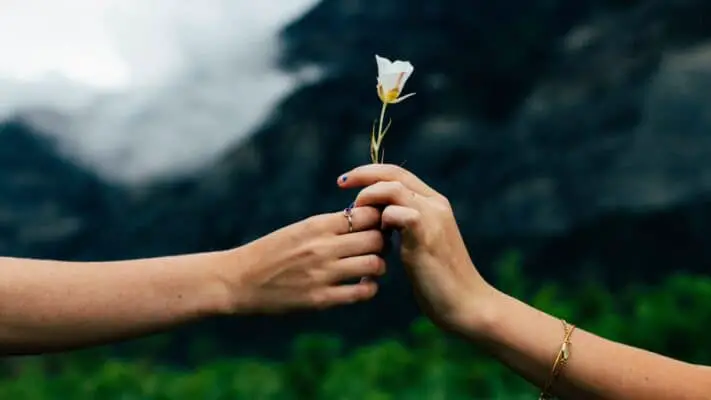
As the first light of dawn peeked through my window, I caught myself amidst the hustle of yet another day. My hands wrapped around a steaming mug of coffee as I stared into the waking world a sudden realization swept over me – gratitude, this humble act of recognizing life’s blessings, had slipped into the unnoticed shadows of my daily routine. I realized I was caught up in the relentless pursuit of doing, having and being more. I had forgotten to appreciate the abundance already present in my life. In that moment, I understood the urgent need to incorporate gratitude practices into my daily life, so as not to lose touch with this vital emotion; thus, the journey that led to the creation of this very blog post commenced.
Gratitude, contrary to what many believe, is not just a polite thank you or an appreciative nod. It’s an integral element of our lives, a transformative force that not only acknowledges the good in our life but also helps us step back, assess, and appreciate our present.
Why, you may ask, is gratitude so important? Research has shown that gratitude can improve mental health, enhance our relationships, increase satisfaction in life, and even boost our physical health. It’s akin to a catalyst, kick-starting a positive feedback loop of happiness and well-being in our lives. And yet, it is often the most overlooked aspect of our daily existence.
In this journey we are about to embark on, my aim is to share with you, 23 unique, even unconventional, ways to cultivate gratitude. From simple everyday practices to innovative weekly rituals, we will explore them all. As we venture into this enlightening path of thankfulness, remember, gratitude is not just an act, it’s a way of life, a perspective to embrace, and a lifelong commitment to appreciating the abundance that surrounds us.
- The Science of Gratitude
- Gratitude Practices: 23 Inspiring Ways to Cultivate Gratitude in Your Life
- 🌟1. Gratitude Jar
- 📸2. Photographic Memories
- 🍃3. Gratitude Walks
- 🍲4. Cooking with Gratitude
- 💌5. Gratitude Letter
- 🌸6. Mindful Savoring
- ⏰7. Gratitude Alarm
- 🖼️8. Gratitude Collage
- 📖9. Book of Thanks
- 🌬️10. Thankful Breaths
- 💎11. Gratitude Stones
- 🌄12. Appreciate Challenges
- 🏡13. Gratitude Visit
- 🎨14. Gratitude Art
- 🌜15. Bedtime Thanks
- ☀️ 16. Gratitude Affirmations
- 🗓️ 17. Weekly Gratitude Schedule
- 👫 18. Gratitude Buddy
- 🎁 19. Random Acts of Kindness
- 🙏 20. Gratitude Prayer
- 🧘 21. Gratitude Meditation
- 🎤 22. Public Acknowledgement
- ✂️ 23. Thankful Crafting
- How to Make Gratitude a Habit
- Real-Life Stories
- Final Thoughts
- Frequently Asked Questions (FAQ) About Practicing Gratitude
- What are some unique ways to practice gratitude daily?
- How can practicing gratitude improve my mental health?
- What are the obstacles to practicing gratitude and how can I overcome them?
- How can I make gratitude a consistent habit in my life?
- Can gratitude help me during challenging times like a crisis?
The Science of Gratitude
The Neuroscience Behind Gratitude
Gratitude, in scientific terms, is more than just a positive emotion or a social norm. It is a complex response that engages multiple areas of the brain. When we express or receive gratitude, our brain releases dopamine and serotonin, the two crucial neurotransmitters responsible for our emotions. They enhance our mood instantly, making us feel ‘happy’. This is the very essence of the ‘gratitude effect’.
Reaping the Benefits: The Gratitude Advantage
Harnessing this ‘gratitude effect’ has shown to yield a bounty of benefits impacting various facets of our life:
- Mental Health: Regular practice of gratitude can decrease levels of stress and depression. By acknowledging our blessings, we can shift our focus from negative aspects to more positive facets of life, promoting psychological well-being.
- Physical Health: A grateful mindset can lead to better sleep, improved immunity, and even lower blood pressure, enhancing our overall health.
- Relationships: Expressing gratitude to our loved ones fosters stronger bonds. It increases our empathy towards others, strengthens social connections, and promotes relationship satisfaction.
- Overall Life Satisfaction: People who routinely acknowledge their blessings report higher levels of positive emotions, life satisfaction, vitality, optimism, and lower levels of depression and stress.
Evidence-Based Benefits: The Studies Speak
The above claims are not just theory. Numerous studies back these benefits of gratitude:
A 2003 study published in Journal of Personality and Social Psychology found that grateful people experience fewer aches and pains and generally feel healthier than other people.
The role of gratitude in promoting resilience during challenging times was underscored in a 2022 study titled “Does Gratitude Promote Resilience During a Pandemic?”. This research found that those with higher gratitude levels experienced better mental health and positivity during the early stages of the COVID-19 pandemic, emphasizing gratitude’s role in fostering resilience and well-being during crises.
A systematic review titled “Effects of gratitude intervention on mental health and well-being among workers” published in 2021 highlighted the power of gratitude in the workplace. It concluded that gratitude interventions could effectively reduce stress and depressive symptoms, thereby enhancing mental health and overall well-being among workers.
The science of gratitude is, in a nutshell, the biology of counting our blessings. By understanding this powerful tool, we are one step closer to cultivating it in our everyday lives.
Gratitude Practices: 23 Inspiring Ways to Cultivate Gratitude in Your Life
Practicing gratitude does not always have to follow the conventional ‘think-positive’ path. It can be as diverse, creative, and dynamic as we allow it to be. Let’s unearth the uncommon practices to cultivating an attitude of gratitude. Here are 23 innovative ways to embrace thankfulness in everyday life:
🌟1. Gratitude Jar
What is it? The Gratitude Jar is a powerful tool that serves as a container for your expressions of thankfulness. The concept is simple – you write down things you’re thankful for and drop them into this jar.
Why is it effective? The Gratitude Jar is a visual reminder of the abundance of good things in your life. It’s a practice that allows you to bring your feelings of gratitude into the physical realm, creating a touchable and visual representation of your thankful thoughts.
Tips to integrate it into daily life: Keep a jar in a prominent place where you can see it daily. Alongside, maintain a notepad and a pen. Each day, jot down a note about something you’re grateful for and drop it into the jar. It could be a small thing, like a sunny day, or something big, like a promotion at work. When you’re having a tough day, open the jar and read a few notes to remind yourself of the good in your life.
📸2. Photographic Memories
What is it? Photographic Memories involves capturing moments or things you’re grateful for through photos.
Why is it effective? Visual stimuli have a profound impact on our emotions. Having a collection of images that remind you of joyful moments can instantly boost your mood and help you to refocus on the positive aspects of your life.
Tips to integrate it into daily life: Use your phone or a camera to capture moments you’re grateful for. These don’t have to be monumental events, even a picture of a serene morning sky can serve as a symbol of gratitude for a new day. Periodically, look through these images and let the feelings of thankfulness wash over you. You might even consider placing these pictures around your home for daily reminders of thankfulness.

🍃3. Gratitude Walks
What is it? Gratitude Walks involve dedicating your daily walks to reflect on things you’re grateful for, transforming a simple walk into a mindful practice of gratitude.
Why is it effective? Walking, especially in natural surroundings, allows you to slow down, connect with the environment, and encourages mindfulness. This mindfulness provides a fertile ground for fostering feelings of gratitude.
Tips to integrate it into daily life: During your regular walks, turn off the autopilot. Try to appreciate your surroundings – the rustling leaves, the warmth of the sun, or the cool breeze. Acknowledge these elements of nature and the sense of well-being they bring.
🍲4. Cooking with Gratitude
What is it? Cooking with Gratitude is about consciously appreciating the ingredients and the nourishment they provide as you prepare your meals.
Why is it effective? This practice not only enhances your relationship with food but also turns a mundane task into a mindfulness exercise. It allows you to appreciate the sources of your sustenance and the labor that brings these ingredients to your kitchen.
Tips to integrate it into daily life: As you prepare your meal, take a moment to appreciate each ingredient. Think about its origin, the effort involved in growing it, and the nourishment it provides. This practice will infuse your meals with a sense of gratitude, making them even more enjoyable.
💌5. Gratitude Letter
What is it? A Gratitude Letter is a heartfelt message to someone expressing your thankfulness. The act of writing itself, even if you don’t send it, fosters a deep sense of gratitude.
Why is it effective? This practice allows you to reflect on the positive people and interactions in your life. It strengthens your relationships and encourages empathy and understanding.
Tips to integrate it into daily life: Think about someone who has made a positive impact on your life. Write them a letter, describing how you feel and why you are grateful for them. You could specify moments where they’ve helped or inspired you, and how these instances shaped your life. Even if you choose not to send the letter, this reflective exercise can deepen your sense of appreciation.
🌸6. Mindful Savoring
What is it? Mindful Savoring is a practice where you engage fully in the present moment and appreciate it. This could be while enjoying a meal, listening to a song, or even sipping your coffee.
Why is it effective? This practice enhances your connection to the present moment and amplifies the joy derived from simple pleasures. It fosters a deeper sense of gratitude by highlighting the beauty and satisfaction available in everyday moments.
Tips to integrate it into daily life: When you are enjoying a meal, try to focus on the taste, aroma, and texture of the food. If you are listening to music, immerse yourself in the melody. For sipping coffee, pay attention to its warmth, the flavor, and how it makes you feel. By being fully present, you amplify your enjoyment and foster a greater appreciation for these experiences.
⏰7. Gratitude Alarm
What is it? The Gratitude Alarm is a strategy where you set random alarms throughout the day. Each time the alarm rings, you pause whatever you’re doing to acknowledge something you’re grateful for.
Why is it effective? This practice provides a regular and consistent reminder to shift your focus towards gratitude. It encourages a frequent mental ‘reset’, bringing you back to a positive mindset, no matter what the day may bring.
Tips to integrate it into daily life: Set several alarms at random intervals throughout your day. When each alarm rings, stop, take a deep breath, and think of something you’re grateful for. It could be as simple as the comfortable chair you’re sitting on or as significant as a loved one’s wellbeing.
🖼️8. Gratitude Collage
What is it? A Gratitude Collage is a collection of images or words, cut out from magazines or printed from the internet, that represent things you’re grateful for.
Why is it effective? Similar to the Photographic Memories technique, this visual display serves as a constant, powerful reminder of the abundance in your life. It encourages a positive mindset and cultivates a daily habit of recognition and appreciation.
Tips to integrate it into daily life: Collect pictures, words, or phrases that resonate with you and compile them into a collage. Place this collage somewhere you will see it frequently – on your fridge, near your desk, or as your mobile or computer wallpaper. Each time you see it, let it remind you of the various reasons you have to be thankful.
📖9. Book of Thanks
What is it? A Book of Thanks is a journal where you write about people, experiences, or things you’re grateful for, in detail.
Why is it effective? The act of writing enhances your emotional processing and deepens your connection to the subject of your gratitude. It provides a space to explore your feelings of thankfulness and serves as a comforting resource to revisit when times are tough.
Tips to integrate it into daily life: Dedicate a specific notebook as your Book of Thanks. Make a habit to write in it regularly, detailing why you are grateful for the chosen person, event, or thing. Over time, you will find that the book has become a treasure trove of positive memories and experiences.

🌬️10. Thankful Breaths
What is it? Thankful Breaths is a practice where you take a few moments in a day to take five deep breaths, contemplating things you’re grateful for with each breath.
Why is it effective? This practice combines the calming effects of deep breathing with the mood-boosting benefits of gratitude. It not only helps in reducing stress but also centers your thoughts on positive aspects of your life.
Tips to integrate it into daily life: Find a quiet moment in your day, take a deep breath in, think of something you’re thankful for, and then slowly breathe out. Repeat this for five breaths, each time considering a different reason for gratitude. This practice will help you to de-stress and reorient your mindset towards positivity.
💎11. Gratitude Stones
What is it? Gratitude Stones are just regular stones that carry a special purpose. Each time you touch or see this stone, it serves as a reminder to think of something you’re grateful for.
Why is it effective? It’s a tangible, physical reminder to pause and reflect on the good in your life. Over time, the simple act of touching the stone becomes associated with feelings of gratitude, bringing about a positive shift in your mindset.
Tips to integrate it into daily life: Choose a stone that resonates with you. It could be a pebble from a memorable place or a stone with an interesting shape or color. Keep it in your pocket or on your desk where you can see or touch it regularly. Each time you do, let it prompt a moment of gratitude.
🌄12. Appreciate Challenges
What is it? This practice involves reflecting on past challenges and identifying aspects of these experiences that you are grateful for, such as personal growth, strength, or insights gained.
Why is it effective? It’s a potent way to transform negative memories into opportunities for gratitude. By appreciating the lessons learned or strengths gained from past difficulties, you can cultivate resilience and a more positive outlook.
Tips to integrate it into daily life: Think about a challenging event from your past. Reflect on the experience and identify positive outcomes that resulted from it, no matter how small. This practice encourages you to view challenges as opportunities for growth and self-discovery.
🏡13. Gratitude Visit
What is it? A Gratitude Visit involves going to see someone who has had a positive impact on your life and expressing your gratitude to them in person.
Why is it effective? Expressing gratitude directly strengthens your relationships and enhances your feelings of connection and happiness. It’s also beneficial for the person receiving your gratitude, making it a win-win practice.
Tips to integrate it into daily life: Think about someone who has significantly affected your life in a positive way. Plan a visit to this person, if possible, and express your thanks face-to-face. If a personal visit isn’t feasible, a video call or heartfelt letter can serve the same purpose.
🎨14. Gratitude Art
What is it? Gratitude Art is any form of art—painting, sketching, sculpting—that represents something you’re grateful for.
Why is it effective? The creative process can be a mindful, therapeutic experience. By choosing subjects that spark gratitude, you cultivate positivity while engaging in a fulfilling, expressive activity.
Tips to integrate it into daily life: Choose an art form you enjoy or want to explore. It doesn’t require professional skills; the goal is to express your feelings through the creative process. Consider creating a piece that symbolizes a person, place, or thing you’re grateful for. Let the process of creation fill you with a sense of appreciation and joy.

🌜15. Bedtime Thanks
What is it? Bedtime Thanks is a practice where, before falling asleep, you think of the best thing that happened during the day and express gratitude for it.
Why is it effective? Ending your day on a positive note promotes better sleep and cultivates a positive perspective. This simple routine can significantly improve your overall sense of wellbeing and satisfaction.
Tips to integrate it into daily life: As you settle into bed each night, reflect on your day and identify the best part of it. It could be a kind gesture, a delicious meal, a completed task, or even a quiet moment of peace. Acknowledge this positive event, express gratitude for it, and carry that positivity into your sleep.
☀️ 16. Gratitude Affirmations
What is it? Gratitude Affirmations involve starting your day with statements of thankfulness. These could be general statements like “I am grateful for this beautiful day” or specific ones like “I am thankful for my loving family.”
Why is it effective? Beginning your day on a positive note can set the tone for the rest of your day. Affirmations help manifest positivity and gratitude into your everyday life.
Tips to integrate it into daily life: Write down a list of gratitude affirmations that resonate with you. Each morning, pick one or a few to recite. Ensure to say them with intention and belief, focusing on the feelings they evoke.
🗓️ 17. Weekly Gratitude Schedule
What is it? This practice involves dedicating each day of the week to be grateful for a specific aspect of your life, like relationships, nature, self, etc.
Why is it effective? Having a structured schedule helps create a routine, ensuring you consistently practice gratitude. By focusing on different aspects of your life each day, you ensure a comprehensive appreciation of your life’s many facets.
Tips to integrate it into daily life: Create a schedule that outlines what you’ll focus your gratitude on each day of the week. For instance, Monday could be for relationships, Tuesday for health, and so on. Tailor it to suit your life and what matters most to you.
👫 18. Gratitude Buddy
What is it? A Gratitude Buddy is a friend with whom you share daily gratitude lists.
Why is it effective? Sharing your gratitude practices with someone else can help hold you accountable. It also allows you to see what others are grateful for, which can inspire your own gratitude.
Tips to integrate it into daily life: Find a friend who is interested in cultivating gratitude. Each day, share with each other at least one thing you’re grateful for. It’s a simple practice that can strengthen your friendship and increase your appreciation of everyday life.
🎁 19. Random Acts of Kindness
What is it? This involves showing your appreciation for others through unexpected kind gestures.
Why is it effective? Acts of kindness not only make others feel good but also increase your own happiness and sense of gratitude. It’s a beautiful cycle where everyone benefits.
Tips to integrate it into daily life: Do something kind for someone else without expecting anything in return. It could be as simple as giving a compliment, helping a neighbor, or buying coffee for the person behind you in line.
🙏 20. Gratitude Prayer
What is it? Regardless of your spiritual beliefs, a Gratitude Prayer is a moment to express thanks to the universe, God, or life itself.
Why is it effective? This practice helps you acknowledge the larger forces at play in your life, promoting a sense of connectedness, humility, and appreciation.
Tips to integrate it into daily life: Find a quiet moment in your day to express your thanks. It could be a formal prayer, a moment of silence, or a spoken word to the universe. Focus on the things you’re grateful for and express your sincere appreciation.
🧘 21. Gratitude Meditation
What is it? Gratitude Meditation involves focusing your meditation on your heart and visualizing gratitude radiating from it.
Why is it effective? Meditating on gratitude helps cultivate a deeper sense of appreciation and positivity. The visualization of gratitude emanating from your heart further strengthens the emotional connection to the feeling of gratitude.
Tips to integrate it into daily life: Choose a quiet place and time for your meditation. Close your eyes, take deep breaths, and focus your mind on your heart area. Visualize feelings of gratitude emanating from your heart, filling your entire body, and radiating outwards.
🎤 22. Public Acknowledgement
What is it? This involves acknowledging people’s efforts publicly, thanking them for their contributions.
Why is it effective? Public acknowledgment not only expresses your gratitude but also validates the person’s efforts and achievements. It fosters positivity, reinforces good behavior, and strengthens relationships.
Tips to integrate it into daily life: In meetings or gatherings, take a moment to acknowledge someone’s hard work or contributions. Express your gratitude sincerely and specify what you’re thanking them for to make it more meaningful.
✂️ 23. Thankful Crafting
What is it? This refers to creating your own gratitude-themed crafts, such as bracelets, bookmarks, or wall hangings.
Why is it effective? Crafting with a focus on gratitude can be a therapeutic and enjoyable way to actively express appreciation. It allows you to create a physical reminder of your gratitude that you can keep or give to someone else.
Tips to integrate it into daily life: Choose a craft that you enjoy (like making bracelets or drawing) and incorporate a gratitude theme into it. For instance, you can make a bracelet with different beads, each representing something you’re grateful for. You can also create a gratitude wall hanging with words or images that remind you of things you appreciate.
How to Make Gratitude a Habit
Living a life of gratitude isn’t something that happens overnight; it’s a habit that you consciously need to cultivate. It might be challenging at times, but the rewards are profound. Let’s explore some strategies that can help make gratitude a consistent practice in your life and how to navigate the potential setbacks on this journey.
Strategies to Make Gratitude Practices Consistent
- Start Small: You don’t need to dive headfirst into every practice mentioned above. Start with one or two that resonate with you and gradually add more as you become comfortable with your routine.
- Integrate into Existing Habits: It’s easier to develop a new habit when you associate it with an existing one. For instance, you can practice your “Thankful Breaths” while waiting for your morning coffee to brew or reflect on your “Gratitude Jar” notes before going to bed.
- Schedule It: If you’re struggling to remember to practice gratitude, set a specific time for it in your daily schedule. Make it a priority, just like any other important task.
- Be Patient with Yourself: Developing a new habit takes time. Don’t be disheartened if you miss a day or two. The key is consistency, not perfection.
Addressing Challenges and Setbacks
- Recognize the Hurdle: Be mindful of what’s holding you back. Is it forgetfulness? Lack of time? Once you identify the issue, you can devise a strategy to overcome it.
- Find a Gratitude Buddy: Having someone to share the journey can make the process more enjoyable and hold you accountable.
- Adjust Your Practices: If a certain practice isn’t working for you, switch it up. The goal is to find practices that resonate with you, not to stick rigidly to ones that don’t.
- Reframe Negative Thoughts: If you’re struggling with negativity or ungrateful thoughts, try to reframe them. For example, instead of thinking “I have to work late again,” you could think, “I’m grateful to have a job that challenges me.”
Embracing gratitude is a personal journey that looks different for everyone. Be kind to yourself, celebrate your progress, and remember that every step you take towards gratitude is a step towards a happier, more fulfilling life.

Real-Life Stories
It’s one thing to discuss the theory and practices of gratitude; it’s another to witness the transformative power of gratitude in real life. Here are a couple of inspiring stories of individuals who’ve managed to turn their lives around with the simple act of being thankful.
Sarah’s Awakening:
Sarah, a high-powered executive, was always on the move, constantly chasing deadlines and striving for the next big promotion. Over time, she began to feel worn out, unfulfilled, and on the brink of burnout. She knew she needed a change.
On a friend’s recommendation, she started keeping a ‘Gratitude Journal,’ jotting down three things she was grateful for every night before going to bed. It felt awkward and forced at first, but she stuck with it. Over time, she began noticing a shift. She was more aware of the positive aspects of her life, and instead of focusing solely on her work, she started appreciating the little moments, like a relaxing cup of tea in the morning or a heartwarming chat with a colleague.
Within a few months, Sarah felt happier and more balanced. She was still ambitious, but she also knew how to slow down and appreciate the journey. She credits her ‘Gratitude Journal’ for this remarkable transformation.
More: Gratitude Journaling: The Ultimate How To Guide >>
Jake’s Path to Forgiveness:
Jake had a falling out with his best friend, and they hadn’t spoken for years. Holding onto the grudge had become second nature to him. One day, he stumbled upon the idea of ‘Gratitude Letters.’ Intrigued, he decided to write one to his estranged friend, expressing his thankfulness for the good times they had shared.
Writing the letter was a cathartic experience for Jake. He began to see the situation from a different perspective, appreciating the life lessons the fall-out had taught him. He realized that his friendship had added value to his life and that the bitterness wasn’t serving him any purpose.
Jake decided to send the letter. His friend responded, and they met up to clear the air. They’re not as close as they once were, but they’ve mended their relationship and let go of the resentment. Jake feels lighter, freer, and more at peace, and it all began with a letter of gratitude.
These stories are just a glimpse of how the power of gratitude can alter the course of one’s life. You, too, can experience such profound shifts by practicing gratitude in your daily life.
Final Thoughts
We began this journey with the promise of transformation, of shifting our perspectives, and embracing a more fulfilling, happier life through the practice of gratitude. And what a journey it has been! From understanding the science behind gratitude to exploring the myriad ways to incorporate it into our everyday lives, we’ve dived deep into the heart of thankfulness.
It’s essential to remember that gratitude is not a one-time event or a box to be checked off. It’s a habit, a way of life that we cultivate over time. It’s about acknowledging the good in our lives, even on the gloomy days. It’s about finding joy in the simple things and peace in our connection with others and ourselves.
Some practices will resonate with you more than others, and that’s perfectly fine. The beauty of these 23 methods is that there’s something for everyone. Maybe you’ll find peace in the act of creating a Gratitude Collage, or perhaps you’ll connect with the profound act of writing a Gratitude Letter. The important thing is to start somewhere and make gratitude a consistent practice.
As we wrap up, I invite you to pick one or two methods that spoke to you the most. Commit to practicing them for the next 30 days. Remember the stories of Sarah and Jake. They were once where you are now, at the beginning of their gratitude journey. Look where it led them!
Gratitude, like any worthwhile endeavor, requires commitment and patience. You will face obstacles and days when it feels like a chore. But stick with it. Because the rewards – a more vibrant, joyful, and connected life – are truly worth it.
And remember, each moment of gratitude brings us closer to a life of greater fulfillment and happiness. So, as you move forward, keep in mind this beautiful quote by Melody Beattie:
"Gratitude turns what we have into enough, and more. It turns denial into acceptance, chaos to order, confusion to clarity. It can turn a meal into a feast, a house into a home, a stranger into a friend." – Melody Beattie #gratitude
— The Daily Positive (@dailypoz) June 21, 2023
In the spirit of gratitude, thank you for taking the time to embark on this journey with me. May your path be filled with joy, appreciation, and an abundance of things to be grateful for. Because, at the end of the day, aren’t we all just travelers finding our way under the vast sky of life, with gratitude as our guiding star?
Frequently Asked Questions (FAQ) About Practicing Gratitude
What are some unique ways to practice gratitude daily?
There are many ways to practice gratitude, such as maintaining a gratitude jar, writing gratitude letters, mindful savoring, creating a gratitude collage, and practicing gratitude meditation. Each of these techniques can help to increase your awareness of the positive aspects of your life.
How can practicing gratitude improve my mental health?
Practicing gratitude can have a positive impact on mental health by improving mood, reducing stress, and increasing overall life satisfaction. Studies show that people who regularly practice gratitude report fewer symptoms of depression and anxiety.
What are the obstacles to practicing gratitude and how can I overcome them?
Some common obstacles to practicing gratitude include busyness, negativity bias, and taking things for granted. Overcoming these obstacles involves being mindful of your thoughts and feelings, practicing positive reframing, and making gratitude a daily habit.
How can I make gratitude a consistent habit in my life?
Making gratitude a consistent habit can be achieved by integrating gratitude practices into your daily routine, setting reminders for gratitude practice, and maintaining a gratitude journal or jar.
Can gratitude help me during challenging times like a crisis?
Yes, gratitude can foster resilience and improve mental health during challenging times. Studies indicate that people who reported higher levels of gratitude experienced better mental health and positivity during crises.
















